Gastroenterology
- Page Path
-
- HOME
- TOPICS
- Gastroenterology
- Topics
-
- Adolescence Medicine (4)
- Allergy (62)
- Cardiology (79)
- Critical Care Medicine (11)
- Developmental and Behavioral Medicine (24)
- Emergency Medicine (5)
- Endocrinology (61)
- Gastroenterology (66)
- General Pediatrics (48)
- Genetics and Metabolism (25)
- Hematology (17)
- Immunology (16)
- Infection (73)
- Neonatology (Perinatology) (124)
- Nephrology (Genitourinary) (53)
- Neurology (95)
- Nutrition (30)
- Oncology (17)
- Neurobehavior (12)
- Pulmonology (32)
- Rheumatology (3)
- Other (37)
- Review Article
- Gastroenterology
- Upper gastrointestinal tract involvement of Crohn disease: clinical implications in children and adolescents
- Eun Sil Kim, Mi Jin Kim
- Clin Exp Pediatr. 2022;65(1):21-28. Published online September 10, 2021
-

· Clinical manifestations of upper gastrointestinal (UGI) tract involvement in Crohn's disease (CD) are common but often clinically underestimated.
· Diagnosing CD by confirming inflammation of the UGI tract histologically is challenging because macroscopic and microscopic findings overlap with those of other diseases.
· Ongoing efforts are needed to enable a standardized assessment of UGI CD in the future.
- Letter to the Editor
- Gastroenterology
- Functional gastrointestinal disorders and smartphone use in adolescents
- Mauro Cinquetti, Marco Biasin, Marco Ventimiglia, Linda Balanzoni, Denise Signorelli, Angelo Pietrobelli
- Clin Exp Pediatr. 2021;64(9):494-496. Published online November 9, 2020
-
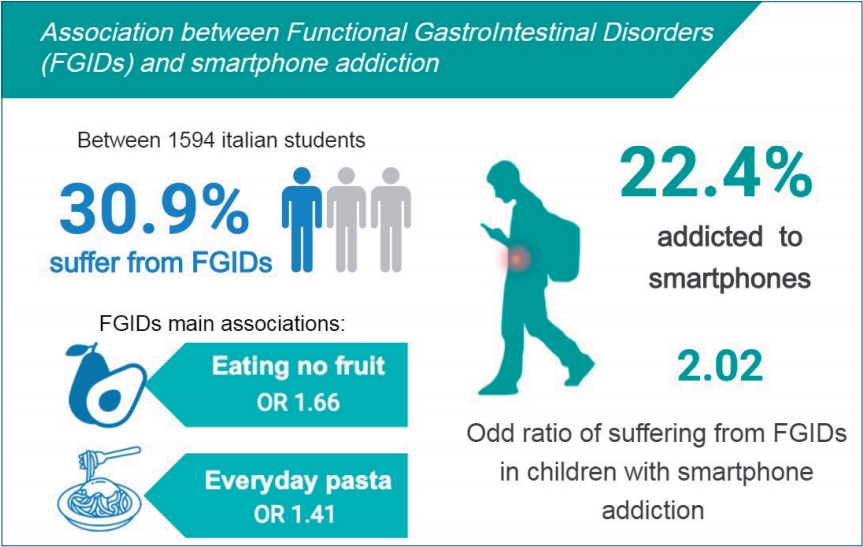
Question: Are functional gastrointestinal disorders (FGIDs) common in Italy? If so, what are the associated risk factors?
Finding: In this cross-sectional study of 1,594 adolescents, the prevalence of FGIDs was 30.9% and was mainly associated with smartphone addiction.
Meaning: Smartphone use and dietary habits should be monitored in children with FGIDs.
- Editorial
- Gastroenterology
- Does smartphone overuse affect functional gastrointestinal disorders?
- Jee Hyun Lee
- Clin Exp Pediatr. 2021;64(9):471-472. Published online December 28, 2020
-

Functional gastrointestinal disorders are common disorders characterized by persistent and recurrent gastrointestinal symptoms. Pathophysiological mechanisms have been suggested, including intestinal microbiota, altered intestinal permeability and motility, dietary effects, sensory abnormalities, and brain-gut dysregulation. Lifestyle factors such as diet, sleep, affect, and physical activity might function as moderators.
- Original Article
- Gastroenterology
- Celiac disease in children: Increasing prevalence and changing clinical presentations
- Hasan M. Isa, Eman Farid, Jaafar J. Makhlooq, Afaf M. Mohamed, Jumana G. Al-Arayedh, Fawzeya A. Alahmed, Shima Medani
- Clin Exp Pediatr. 2021;64(6):301-309. Published online October 17, 2020
-
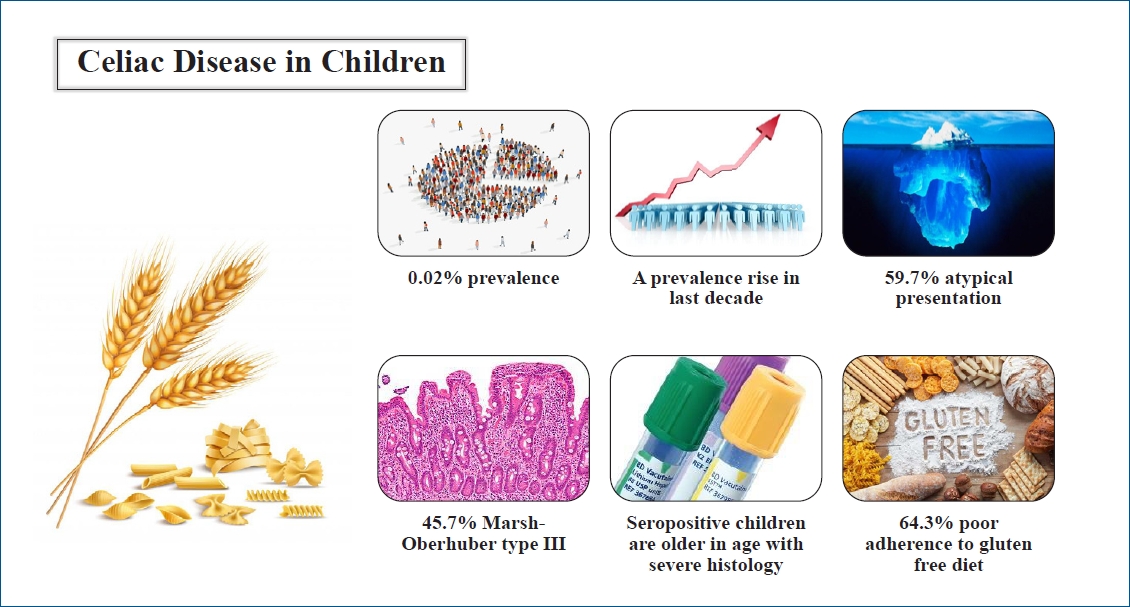
Question: What are the prevalence and clinical characteristics of celiac disease (CD) in children in Bahrain?
Finding: We found a significant increase in CD prevalence over the last decade (P=0.0001). A male predominance was noted. Atypical presentations were common. Most patients had poor adherence to a gluten-free diet.
Meaning: CD is an underdiagnosed condition. Atypical symptoms should be considered to prevent missing patients with CD.
- Review Article
- Gastroenterology
- Causes of acute gastroenteritis in Korean children between 2004 and 2019
- Eell Ryoo
- Clin Exp Pediatr. 2021;64(6):260-268. Published online September 18, 2020
-

· Norovirus is the most common virus in Korean children with acute gastroenteritis.
· Escherichia coli and Salmonella spp. are the most common cause of bacterial gastroenteritis in Korean children, with a detection rate of 3%–20%.
· Uncommon bacterial and parasitic gastroenteritis require attention because of increasing international exchange and overseas travel.
- Original Article
- Gastroenterology
- Value of the International Classification of Diseases code for identifying children with biliary atresia
- Pornthep Tanpowpong, Chatmanee Lertudomphonwanit, Pornpimon Phuapradit, Suporn Treepongkaruna
- Clin Exp Pediatr. 2021;64(2):80-85. Published online August 24, 2020
-

Question: What is the value of the diagnostic code in identifying cases of biliary atresia in a large administrative database?
Finding: The diagnostic code’s accuracy and sensitivity are acceptable for identifying algorithm-defined cases. A history of pale stool and a presumed diagnosis of biliary atresia prior to referral added value.
Meaning: The addition of clinical data to the diagnostic code significantly increased the diagnostic yield.
- Noninvasive markers for esophageal varices in children with cirrhosis
- Parisa Rahmani, Fatemeh Farahmand, Ghobad Heidari, Azadeh Sayarifard
- Clin Exp Pediatr. 2021;64(1):31-36. Published online July 21, 2020
-
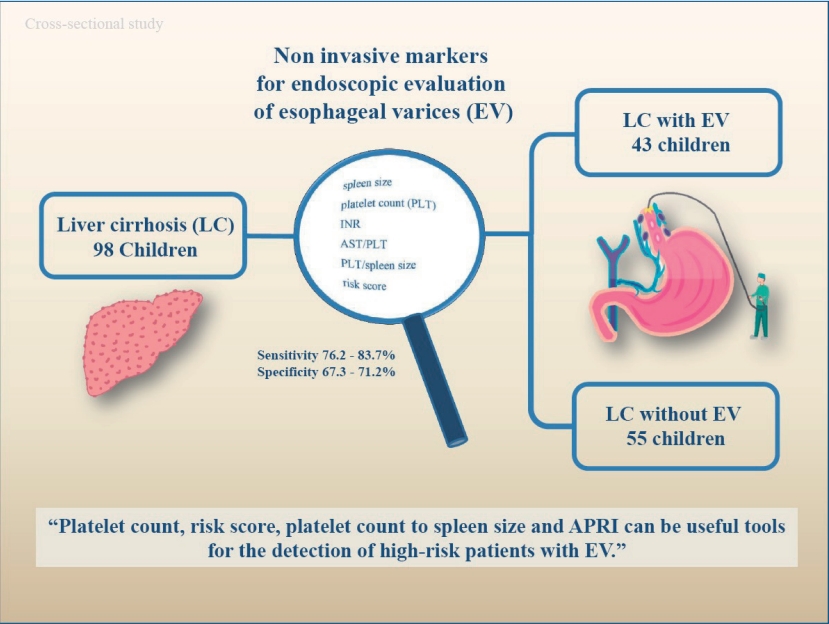
Question: Can noninvasive biomarkers identify esophageal varices among children with esophageal cirrhosis?
Finding: The spleen size, platelet count, international normalized ratio, aspartate aminotransferase to platelet ratio index, platelet count to spleen size ratio, and risk score differed significantly between the patients with and those without esophageal varices.
Meaning: These biological parameters can predict esophageal varices among pediatric patients and indicate the need for esophagogastroduodenoscopy.
- Review Article
- Gastroenterology
- Changing prevalence of Helicobacter pylori infection in children and adolescents
- Ji Sook Park, Jin Su Jun, Ji-Hyun Seo, Hee-Shang Youn, Kwang-Ho Rhee
- Clin Exp Pediatr. 2021;64(1):21-25. Published online July 15, 2020
-
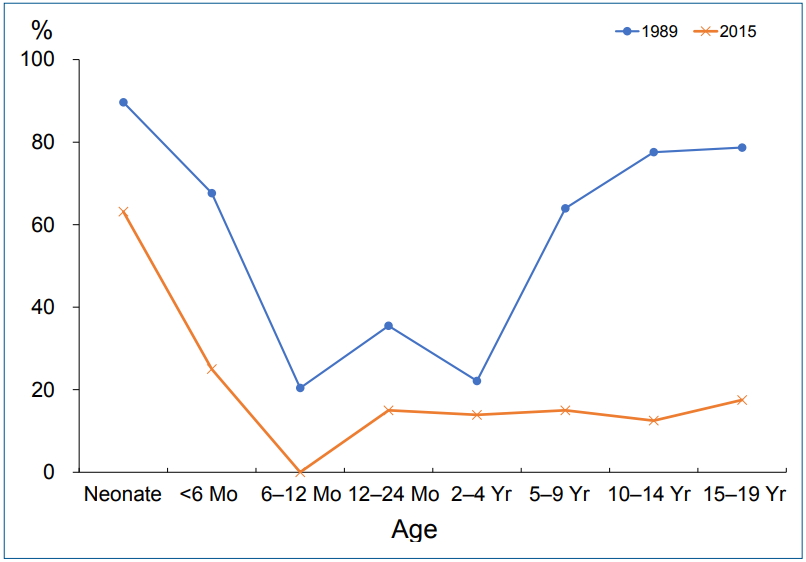
Although Helicobacter pylori infection rate in children is unclear due to diversity and limitation of diagnostic tests unlike in adults, investigation the childhood prevalence is important for predicting H. pylori-related diseases in the future.
H. pylori infection occurred in early childhood, and declined during 30 years in our study.
Change in risk factors of H. pylori transmission and consensus for eradication therapy in children might further reduce the infection rate.
- Original Article
- Gastroenterology
- Evaluating the effects of probiotics in pediatrics with recurrent abdominal pain
- Parisa Rahmani, Azin Ghouran-orimi, Farzaneh Motamed, Alireza Moradzadeh
- Clin Exp Pediatr. 2020;63(12):485-490. Published online July 21, 2020
-
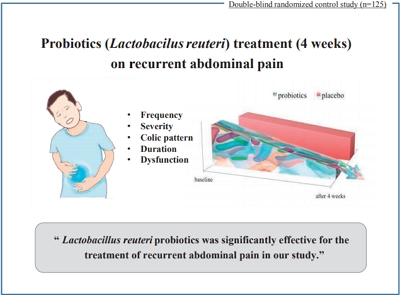
Question: ecurrent abdominal pain (RAP) is a chief complaint among pediatrics and is associated with reduced quality of life, for both parent and child, and economic burden. Does probiotics reduce the frequency of RAP among children?
Finding: This study reported the effects of Lactobacillus reuteri probiotics among children with RAP as a result of multiple etiologies.
Meaning: The administration of probiotic supplements is significantly associated with pain relief among RAP children presented with functional abdominal pain, irritable bowel syndrome, and functional dyspepsia.
- Acquired noncaustic esophageal strictures in children
- Elif Sag, Aysenur Bahadir, Mustafa Imamoglu, Sefa Sag, Gokce Pinar Reis, Erol Erduran, Murat Cakir
- Clin Exp Pediatr. 2020;63(11):447-450. Published online October 15, 2020
-

Question: Which clinical findings suggest esophageal structure in children with dysphagia?
Finding: The presence of solid dysphagia, malnutrition, and a comorbid condition is suggestive of esophageal stricture in children with dysphagia.
Meaning: Patients with findings suggestive of noncaustic esophageal stricture should receive early referral to pediatric gastroenterology units.
- Editorial
- Gastroenterology
- Dietary role in the development and treatment of inflammatory bowel disease
- Jae Young Kim
- Clin Exp Pediatr. 2020;63(9):355-356. Published online July 13, 2020
-
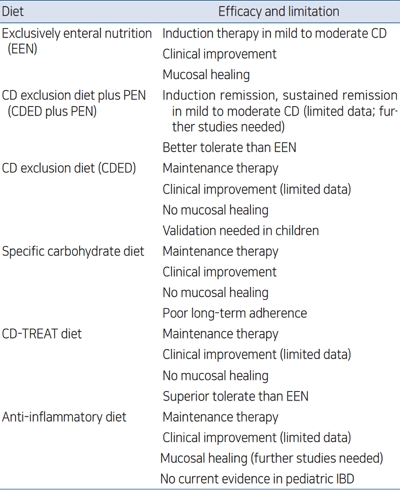
Although the precise pathogenesis of inflammatory bowel disease (IBD) is unclear, dietary factors seem to play a significant role. Dietary modifications including enteral nutrition and the Crohn disease exclusion, specific carbohydrate, and anti-inflammatory diets show a potential ability to downregulate gut inflammation. These nutritional interventions have various degree of efficacies with limited side effects profile for treating pediatric IBD, but data from randomized prospective studies are lacking, and further studies are warranted.
- Review Article
- Gastroenterology
- Increasing incidence of inflammatory bowel disease in children and adolescents: significance of environmental factors
- Sowon Park, Yunkoo Kang, Hong Koh, Seung Kim
- Clin Exp Pediatr. 2020;63(9):337-344. Published online December 6, 2019
-
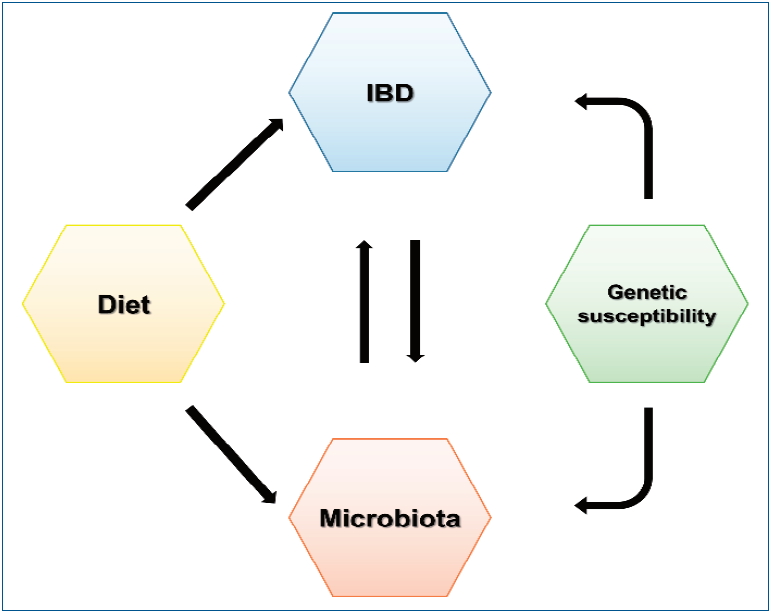
Inflammatory bowel disease (IBD) is a chronic relapsing immune-mediated disease of the intestinal tract. Although its prevalence is reportedly lower in Asia than in Western countries, the rapid increase in the incidence of IBD has drawn attention to its etiology, including genetic susceptibility and environmental factors. Specifically, recent studies concerning dietary treatments and intestinal microbiota suggest that these factors may...
- Editorial
- Gastroenterology
- Management of perianal abscess and fistula-in-ano in infants and children
- Jinyoung Park
- Clin Exp Pediatr. 2020;63(7):261-262. Published online March 23, 2020
-
- Original Article
- Gastroenterology
- Thyroid disturbances in children treated with combined pegylated interferon-alpha and ribavirin for chronic hepatitis C
- Yasser K. Rashed, Fatma A. Khalaf, Sobhy E. Kotb
- Clin Exp Pediatr. 2020;63(2):52-55. Published online September 27, 2019
-

Background: Immunomodulatory properties of interferon (IFN) have been documented. It may induce autoimmune diseases such as autoimmune thyroiditis with hypo- or hyperthyroidism. In addition, it may impair thyroid hormone synthesis through affecting iodide organification in thyroid gland.
Purpose: The aim of this study was to describe thyroid function tests disturbances in children with chronic hepatitis C (CHC) receiving pegylated interferon-alpha (PEG...
- Editorial
- Gastroenterology
- Strategies for treating and managing chronic hepatitis C in children in the direct-acting antiviral era
- Suk-Jin Hong, Byung-Ho Choe
- Clin Exp Pediatr. 2020;63(2):46-47. Published online February 6, 2020
-

- Original Article
- Gastroenterology
- Association between Body Mass Index and Hepatitis B antibody seropositivity in children
- Yoowon Kwon, Su Jin Jeong
- Clin Exp Pediatr. 2019;62(11):416-421. Published online August 12, 2019
-
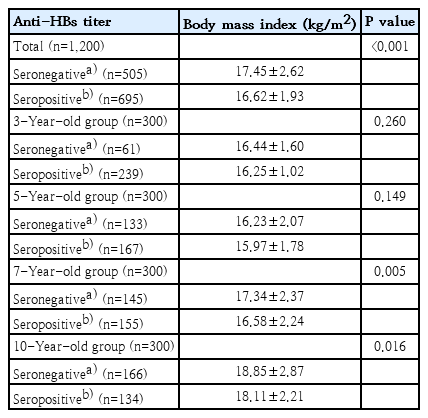
Background: The seropositivity rate of hepatitis B surface antigen (anti-HBs) antibodies is known to be ≥95% after hepatitis B virus vaccination during infancy. However, a low level or absence of anti-HBs in healthy children is discovered in many cases. Recent studies in adults reported that a reduced anti-HBs production rate is related to obesity.
Purpose: To investigate whether body mass index...
- Influence of proton pump inhibitor therapy on intestinal inflammation assessed by fecal calprotectin in pediatric patients
- Su Yeong Kim, Na Mi Lee, Sin Weon Yun, Soo Ahn Chae, In Seok Lim, Eung Sang Choi, Dae Yong Yi
- Clin Exp Pediatr. 2019;62(10):400-404. Published online July 3, 2019
-

Background: An increase in the numbers of patients with gastrointestinal symptoms has recently been observed.
Purpose: To investigate the effects of proton pump inhibitor (PPI) therapy on intestinal inflammation in children and adolescents as confirmed by clinical manifestations and objectively assessed by fecal calprotectin (FC) level measurement. Methods: Consecutive children (aged 3–18 years) who presented with gastrointestinal symptoms and were treated with...
- Endoscopic postdilatation application of Mitomycin C in children with resistant esophageal strictures
- Yasser K. Rashed, Mohamed El-Guindi
- Clin Exp Pediatr. 2019;62(10):395-399. Published online June 24, 2019
-

Background: The esophagus is the most common part of gastrointestinal (GI) tract at the risk of stricture. Benign disorders are the leading causes of narrowing. Caustic ingestion is the most common cause of esophageal stricture in children, especially in developing countries. Clinical responses to the topical application of Mitomycin C in various medical procedures have been reported.
Purpose: The study aimed...
- Editorial
- Gastroenterology
- Can proton pump inhibitors cause intestinal inflammation in children?
- Ben Kang
- Clin Exp Pediatr. 2019;62(10):384-385. Published online October 2, 2019
-
- Review Article
- Gastroenterology
- The role of fecal calprotectin in pediatric disease
- Su Jin Jeong
- Clin Exp Pediatr. 2019;62(8):287-291. Published online March 28, 2019
-

Fecal calprotectin (FC) is a calcium- and zinc-binding protein of the S100 family, mainly expressed by neutrophils and released during inflammation. FC became an increasingly useful tool both for gastroenterologists and for general practitioners for distinguishing inflammatory bowel disease (IBD) from irritable bowel syndrome. Increasing evidences support the use of this biomarker for diagnosis, follow-up and evaluation of response to...
- Original Article
- Gastroenterology
- The role of Lactobacillus reuteri DSM 17938 for the absorption of iron preparations in children with iron deficiency anemia
- Jeanette Manoppo, Hilda Tasiringan, Audrey Wahani, Adrian Umboh, Max Mantik
- Clin Exp Pediatr. 2019;62(5):173-178. Published online January 25, 2019
-
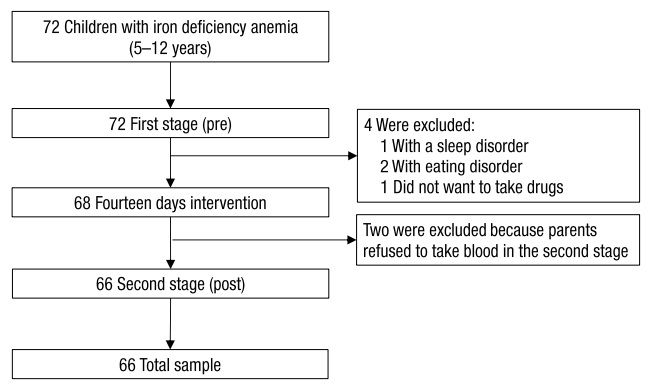
Purpose: To determine whether Lactobacillus reuteri DSM 17938 plays a role in absorption of iron preparations given to children with iron deficiency anemia (IDA). Methods: We performed a quasi-experimental study involving pre- and postintervention tests using a control group in North Sulawesi province, Indonesia, between July and September 2017. We conducted a single-blind controlled trial that included primary school children who...
- Nonalcoholic fatty liver disease in obese and nonobese pediatric patients
- Eun Jeong Kim, Hyun Jin Kim
- Clin Exp Pediatr. 2019;62(1):30-35. Published online September 17, 2018
-
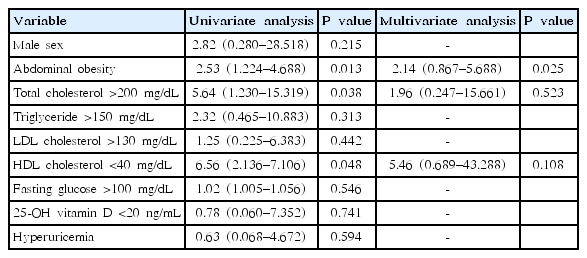
Purpose: Obesity is risk factor for nonalcoholic fatty liver disease (NAFLD). However, nonobese patients are also increasingly susceptible to NAFLD. The aim of this study was to compare the clinical characteristics of obese and nonobese pediatric patients with NAFLD. Methods: We retrospectively studied 68 patients who were diagnosed with NAFLD between January 2010 and October 2016 at 10–18 years of age....
- Review Article
- Gastroenterology
- Esophageal perforation in children: etiology and management, with special reference to endoscopic esophageal perforation
- Krishna Kumar Govindarajan
- Clin Exp Pediatr. 2018;61(6):175-179. Published online June 25, 2018
-
Perforation of the esophagus is an uncommon problem with significant morbidity and mortality. In children undergoing endoscopy, the risk of perforation is higher when interventional endoscopy is performed. The clinical features depend upon the site of esophageal perforation. Opinions vary regarding the optimal treatment protocol, and the role of conservative management in this context is not well established. Esophageal perforation...
- Case Report
- Gastroenterology
- Intestinal duplication revealed by posterior reversible encephalopathy syndrome
- Yosra Kerkeni, Hela Louati, Mourad Hamzaoui
- Clin Exp Pediatr. 2018;61(4):132-134. Published online April 23, 2018
-
We report a unique case of intestinal duplication detected on posterior reversible encephalopathy syndrome (PRES) in a 13-year-old girl. She was admitted to the pediatric Emergency Department because of generalized seizures. Radiological assessment revealed a large, well-defined, thick-walled cystic lesion in the mid abdomen, suggestive of duplication cyst associated to a PRES. Exploration confirmed the diagnosis of ileal duplication cyst,...
- Original Article
- Gastroenterology
- Clinical manifestation of
Campylobacter enteritis in children - Joon Yeol Bae, Dong Hyuk Lee, Kyung Ok Ko, Jae Woo Lim, Eun Jeong Cheon, Young Hwa Song, Jung Min Yoon
- Clin Exp Pediatr. 2018;61(3):84-89. Published online February 28, 2018
-
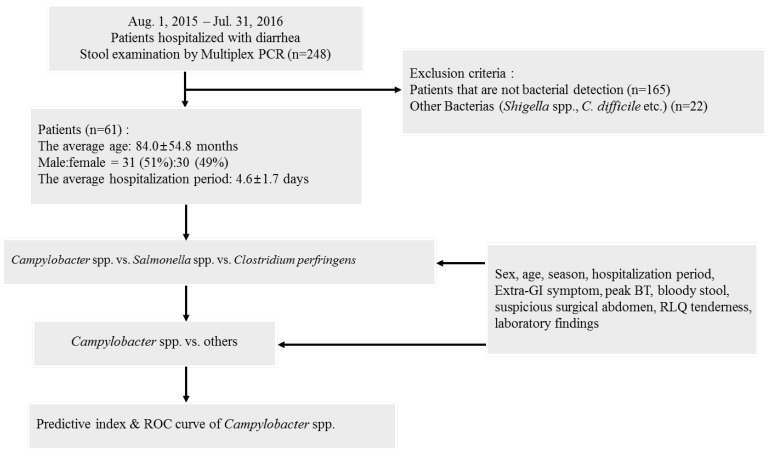
Purpose Timely antibiotic therapy in selected cases of diarrhea associated with bacterial infections can reduce the duration and severity of illness and prevent complications. The availability of a predictive index before identification of causative bacteria would aid in the choice of a therapeutic agent.
Methods The study included patients admitted to the pediatrics unit at Konyang University Hospital for acute inflammatory diarrhea from...
- Characteristics and prognosis of hepatic cytomegalovirus infection in children: 10 years of experience at a university hospital in Korea
- Chae-Yeon Min, Joo Young Song, Su Jin Jeong
- Clin Exp Pediatr. 2017;60(8):261-265. Published online August 14, 2017
-
Purpose Studies on cytomegalovirus (CMV) infections in immunocompetent children are lacking, and minimal information is available in the medical literature on hepatic manifestations and complications of CMV. The aims of this study were to evaluate the clinical characteristics, laboratory data, and prognosis of children with CMV hepatitis, and to investigate its prevalence at a single medical center in Korea over a...
- Case Report
- Gastroenterology
- Acute gastritis associated with Epstein-Barr virus infection in a child
- Ji Mok Kim, Chun Woo Song, Kyu Sang Song, Jae Young Kim
- Clin Exp Pediatr. 2016;59(Suppl 1):S68-S71. Published online November 30, 2016
-
Infectious mononucleosis is Epstein-Barr virus (EBV) inducing a self-limiting clinical syndrome characterized by fever, sore throat, hepatosplenomegaly, and generalized lymphadenopathy. Gastrointestinal symptoms of EBV infection are nonspecific and occur rarely. EBV inducing acute gastrointestinal pathology is poorly recognized without suspicion. Careful consideration is needed to diagnose gastric involvement of EBV infection including gastric lymphoma, gastric cancer, and gastritis. A few...
- Granular cell tumor of the esophagus in an adolescent
- Ji Sun Lee, Kyung Ok Ko, Jae Woo Lim, Eun Jeong Cheon, Young Jin Kim, Jang Sin Son, Jung Min Yoon
- Clin Exp Pediatr. 2016;59(Suppl 1):S88-S91. Published online November 30, 2016
-
Esophageal granular cell tumor (GCT) is a rare neoplasm originating from the Schwann cells of the submucosal neuronal plexus. Histology is the gold standard for its diagnosis. Endoscopic resection or surgical excision should be considered, depending on the potential for malignancy. Here, we report a case of an esophageal GCT in an adolescent. A 12-year-old boy presented with a 1-year...
- Original Article
- Gastroenterology
- Risk factors of delayed diagnosis of acute appendicitis in children: for early detection of acute appendicitis
- Jea Yeon Choi, Eell Ryoo, Jeong Hyun Jo, Tchah Hann, Seong Min Kim
- Clin Exp Pediatr. 2016;59(9):368-373. Published online September 21, 2016
-
Purpose This study examined the risk factors of a delayed diagnosis of acute appendicitis in children undergoing an appendectomy.
Methods This retrospective study involved children aged below 18 years, who underwent an appendectomy. After dividing them into a delayed diagnosis group and nondelayed diagnosis group according to the time interval between the initial hospital visit and final diagnosis, the risk factors of delayed...
- Clinical significance of serum alanine aminotransferase and lifestyle intervention in children with nonalcoholic fatty liver disease
- Kyoung Ah Kwon, Peter Chun, Jae Hong Park
- Clin Exp Pediatr. 2016;59(9):362-367. Published online September 21, 2016
-
Purpose This study aimed to investigate the clinical significance of serum alanine aminotransferase (ALT) levels in children with nonalcoholic fatty liver disease (NAFLD) and the effect of lifestyle intervention on NAFLD.
Methods The clinical data of 86 children diagnosed with NAFLD were reviewed retrospectively. Forty-six patients belonged to the elevated ALT group and 40 to the normal ALT group. The clinical parameters of...
-

-
-
6.02024CiteScore98th percentilePowered by
-
Impact Factor3.6
-
- TOPICS
- ARTICLE CATEGORY
- Editorial Office
-
Korean Pediatric Society
#1606 Seocho World Officetel, 19 Seoun-ro, Seocho-ku, Seoul 06732, Korea
Tel: +82-2-3473-7306 Fax: +82-2-3473-7307 E-mail: office@e-cep.org
Clinical and Experimental Pediatrics is an open access journal. All articles are distributed under the terms of the Creative Commons Attribution NonCommercial License (http://creativecommons.org/licenses/by-nc/4.0/)
Copyright © 2025 by Korean Pediatric Society.











